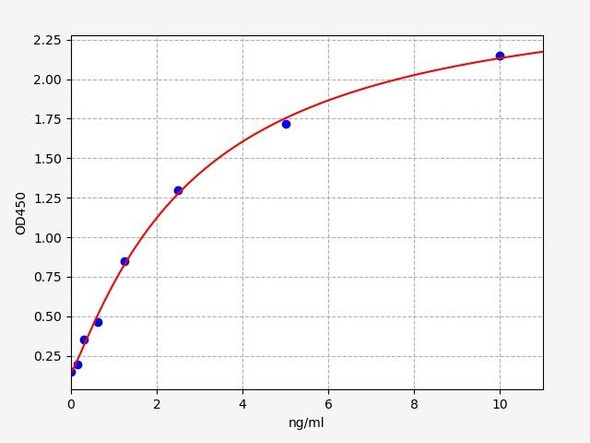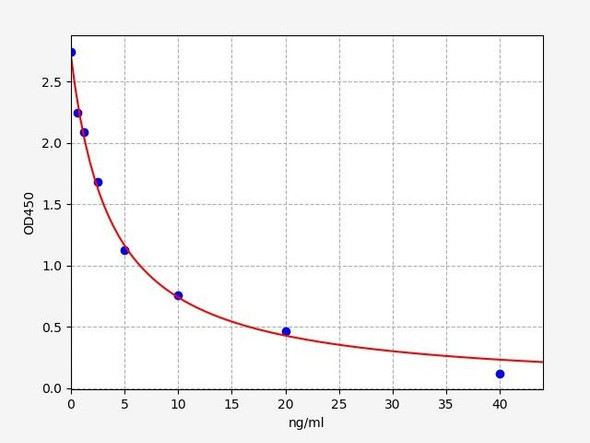Human E3 ubiquitin-protein ligase TRIM21 (TRIM21) ELISA Kit (HUEB0553)
- SKU:
- HUEB0553
- Product Type:
- ELISA Kit
- Size:
- 96 Assays
- Uniprot:
- P19474
- Range:
- 0.312-20 ng/mL
- ELISA Type:
- Sandwich
- Synonyms:
- 52 kDa Ro protein, RING finger protein 81, RNF81, Ro, SS A, RO52, SS A, SSA, SSA1, TRIM21, tripartite motif containing 21
- Reactivity:
- Human
Description
Human E3 ubiquitin-protein ligase TRIM21 (TRIM21) ELISA Kit
The Human E3 Ubiquitin Protein Ligase TRIM21 ELISA Kit is a powerful tool for detecting levels of TRIM21 in human samples such as serum, plasma, and cell culture supernatants. This kit offers exceptional sensitivity and specificity, ensuring accurate and reliable results for a variety of research applications.TRIM21 is a key protein involved in the ubiquitination process, playing a crucial role in regulating protein degradation and immune responses. Dysregulation of TRIM21 has been associated with various diseases, including autoimmune disorders, viral infections, and cancer.
As such, the Human E3 Ubiquitin Protein Ligase TRIM21 ELISA Kit serves as a valuable tool for studying these conditions and exploring potential therapeutic interventions.The kit is easy to use and provides fast and precise results, making it an indispensable resource for researchers looking to investigate the role of TRIM21 in health and disease. Order your Human E3 Ubiquitin Protein Ligase TRIM21 ELISA Kit today and unlock new insights into the intricate mechanisms of cellular function.
| Product Name: | Human E3 ubiquitin-protein ligase TRIM21 (TRIM21) ELISA Kit |
| SKU: | HUEB0553 |
| Size: | 96T |
| Target: | Human E3 ubiquitin-protein ligase TRIM21 (TRIM21) |
| Synonyms: | 52 kDa Ro protein, 52 kDa ribonucleoprotein autoantigen Ro/SS-A, RING finger protein 81, RING-type E3 ubiquitin transferase TRIM21, Ro(SS-A), Sjoegren syndrome type A antigen, Tripartite motif-containing protein 21, SS-A, RNF81, RO52, SSA1 |
| Assay Type: | Sandwich |
| Detection Method: | ELISA |
| Reactivity: | Human |
| Detection Range: | 0.312-20ng/mL |
| Sensitivity: | 0.178ng/mL |
| Intra CV: | 6.5% | ||||||||||||||||||||
| Inter CV: | 9.3% | ||||||||||||||||||||
| Linearity: |
| ||||||||||||||||||||
| Recovery: |
| ||||||||||||||||||||
| Function: | E3 ubiquitin-protein ligase whose activity is dependent on E2 enzymes, UBE2D1, UBE2D2, UBE2E1 and UBE2E2. Forms a ubiquitin ligase complex in cooperation with the E2 UBE2D2 that is used not only for the ubiquitination of USP4 and IKBKB but also for its self-ubiquitination. Component of cullin-RING-based SCF (SKP1-CUL1-F-box protein) E3 ubiquitin-protein ligase complexes such as SCF(SKP2)-like complexes. A TRIM21-containing SCF(SKP2)-like complex is shown to mediate ubiquitination of CDKN1B ('Thr-187' phosphorylated-form), thereby promoting its degradation by the proteasome. Monoubiquitinates IKBKB that will negatively regulates Tax-induced NF-kappa-B signaling. Negatively regulates IFN-beta production post-pathogen recognition by polyubiquitin-mediated degradation of IRF3. Mediates the ubiquitin-mediated proteasomal degradation of IgG1 heavy chain, which is linked to the VCP-mediated ER-associated degradation (ERAD) pathway. Promotes IRF8 ubiquitination, which enhanced the ability of IRF8 to stimulate cytokine genes transcription in macrophages. Plays a role in the regulation of the cell cycle progression. Enhances the decapping activity of DCP2. Exists as a ribonucleoprotein particle present in all mammalian cells studied and composed of a single polypeptide and one of four small RNA molecules. At least two isoforms are present in nucleated and red blood cells, and tissue specific differences in RO/SSA proteins have been identified. The common feature of these proteins is their ability to bind HY RNAs.2. Involved in the regulation of innate immunity and the inflammatory response in response to IFNG/IFN-gamma. Organizes autophagic machinery by serving as a platform for the assembly of ULK1, Beclin 1/BECN1 and ATG8 family members and recognizes specific autophagy targets, thus coordinating target recognition with assembly of the autophagic apparatus and initiation of autophagy. Acts as an autophagy receptor for the degradation of IRF3, hence attenuating type I interferon (IFN)-dependent immune responses (PubMed:26347139). |
| Uniprot: | P19474 |
| Sample Type: | Serum, plasma, tissue homogenates, cell culture supernates and other biological fluids |
| Specificity: | Natural and recombinant human E3 ubiquitin-protein ligase TRIM21 |
| Sub Unit: | Homotrimer (PubMed:17156811) (PubMed:26347139). Interacts (via C-terminus) with IRF8 (via C-terminus) (By similarity). Component of a SCF(SKP2)-like complex containing CUL1, SKP1, TRIM21 and SKP2. Interacts with CALR, CUL1, FBXW11, HSPA5, IKBKB, IRF3, SKP1 and VCP. Interacts with SKP2; the interaction with SKP2 does not depend on an intact F-box domain. Interacts (via N-terminus and C-terminus) with DCP2 (via N-terminus and C-terminus). Interacts with ULK1, BECN1 and with ATG8 family members, including GABARAP, GABARAPL1, GABARAPL2 and MAP1LC3C/LC3C. Interacts with TRIM21 and SQSTM1/sequestosome 1. Interacts with IRF3 (PubMed:26347139). |
| Subcellular Location: | Cytoplasm Cytoplasmic vesicle Autophagosome Nucleus Cytoplasm P-body Enters the nucleus upon exposure to nitric oxide. Localizes to small dot- or rod-like structures in the cytoplasm, called cytoplasmic bodies (P-body) that are located underneath the plasma membrane and also diffusely in the cytoplasm and are highly motil in cells. Cytoplasmic bodies are located along the microtubules and do not share the same cytoplasmic bodies with TRIM5. Colocalizes with DCP2 in P-body. |
| Storage: | Please see kit components below for exact storage details |
| Note: | For research use only |
| UniProt Protein Function: | TRIM21: E3 ubiquitin-protein ligase whose activity is dependent on E2 enzymes, UBE2D1, UBE2D2, UBE2E1 and UBE2E2. Forms a ubiquitin ligase complex in cooperation with the E2 UBE2D2 that is used not only for the ubiquitination of USP4 and IKBKB but also for its self-ubiquitination. Component of cullin-RING-based SCF (SKP1-CUL1-F-box protein) E3 ubiquitin-protein ligase complexes such as SCF(SKP2)-like complexes. A TRIM21-containing SCF(SKP2)- like complex is shown to mediate ubiquitination of CDKN1B ('Thr- 187' phosphorylated-form), thereby promoting its degradation by the proteasome. Monoubiquitinates IKBKB that will negatively regulates Tax-induced NF-kappa-B signaling. Negatively regulates IFN-beta production post-pathogen recognition by polyubiquitin- mediated degradation of IRF3. Mediates the ubiquitin-mediated proteasomal degradation of IgG1 heavy chain, which is linked to the VCP-mediated ER-associated degradation (ERAD) pathway. Promotes IRF8 ubiquitination, which enhanced the ability of IRF8 to stimulate cytokine genes transcription in macrophages. Plays a role in the regulation of the cell cycle progression. Enhances the decapping activity of DCP2. Exists as a ribonucleoprotein particle present in all mammalian cells studied and composed of a single polypeptide and one of four small RNA molecules. At least two isoforms are present in nucleated and red blood cells, and tissue specific differences in RO/SSA proteins have been identified. The common feature of these proteins is their ability to bind HY RNAs.2. Belongs to the TRIM/RBCC family. 2 isoforms of the human protein are produced by alternative splicing. |
| UniProt Protein Details: | Protein type:Ubiquitin conjugating system; EC 6.3.2.-; Ligase; Ubiquitin ligase Chromosomal Location of Human Ortholog: 11p15.5 Cellular Component: nucleoplasm; cytoplasm; SCF ubiquitin ligase complex; cytosol; nucleus; ribonucleoprotein complex Molecular Function:identical protein binding; protein binding; DNA binding; zinc ion binding; RNA binding; ubiquitin-protein ligase activity; ligase activity Biological Process: protein monoubiquitination; regulation of interferon type I production; negative regulation of viral transcription; protein autoubiquitination; protein polyubiquitination; positive regulation of virion penetration into host cell; protein destabilization; inhibition of NF-kappaB transcription factor; cytokine and chemokine mediated signaling pathway; positive regulation of interferon type I production; protein ubiquitination; innate immune response; positive regulation of cell cycle; positive regulation of transcription factor activity; cell cycle |
| NCBI Summary: | This gene encodes a member of the tripartite motif (TRIM) family. The TRIM motif includes three zinc-binding domains, a RING, a B-box type 1 and a B-box type 2, and a coiled-coil region. The encoded protein is part of the RoSSA ribonucleoprotein, which includes a single polypeptide and one of four small RNA molecules. The RoSSA particle localizes to both the cytoplasm and the nucleus. RoSSA interacts with autoantigens in patients with Sjogren syndrome and systemic lupus erythematosus. Alternatively spliced transcript variants for this gene have been described but the full-length nature of only one has been determined. [provided by RefSeq, Jul 2008] |
| UniProt Code: | P19474 |
| NCBI GenInfo Identifier: | 133250 |
| NCBI Gene ID: | 6737 |
| NCBI Accession: | P19474.1 |
| UniProt Secondary Accession: | P19474,Q5XPV5, Q96RF8, |
| UniProt Related Accession: | P19474 |
| Molecular Weight: | 475 |
| NCBI Full Name: | E3 ubiquitin-protein ligase TRIM21 |
| NCBI Synonym Full Names: | tripartite motif containing 21 |
| NCBI Official Symbol: | TRIM21 |
| NCBI Official Synonym Symbols: | SSA; RO52; SSA1; RNF81; Ro/SSA |
| NCBI Protein Information: | E3 ubiquitin-protein ligase TRIM21; SS-A; ro(SS-A); 52 kDa Ro protein; RING finger protein 81; Sicca syndrome antigen A; tripartite motif-containing 21; sjoegren syndrome type A antigen; tripartite motif-containing protein 21; 52 kDa ribonucleoprotein aut |
| UniProt Protein Name: | E3 ubiquitin-protein ligase TRIM21 |
| UniProt Synonym Protein Names: | 52 kDa Ro protein; 52 kDa ribonucleoprotein autoantigen Ro/SS-A; RING finger protein 81; Ro(SS-A); Sjoegren syndrome type A antigen; SS-A; Tripartite motif-containing protein 21 |
| Protein Family: | Serotype-specific antigen |
| UniProt Gene Name: | TRIM21 |
| UniProt Entry Name: | RO52_HUMAN |
| Component | Quantity (96 Assays) | Storage |
| ELISA Microplate (Dismountable) | 8×12 strips | -20°C |
| Lyophilized Standard | 2 | -20°C |
| Sample Diluent | 20ml | -20°C |
| Assay Diluent A | 10mL | -20°C |
| Assay Diluent B | 10mL | -20°C |
| Detection Reagent A | 120µL | -20°C |
| Detection Reagent B | 120µL | -20°C |
| Wash Buffer | 30mL | 4°C |
| Substrate | 10mL | 4°C |
| Stop Solution | 10mL | 4°C |
| Plate Sealer | 5 | - |
Other materials and equipment required:
- Microplate reader with 450 nm wavelength filter
- Multichannel Pipette, Pipette, microcentrifuge tubes and disposable pipette tips
- Incubator
- Deionized or distilled water
- Absorbent paper
- Buffer resevoir
*Note: The below protocol is a sample protocol. Protocols are specific to each batch/lot. For the correct instructions please follow the protocol included in your kit.
Allow all reagents to reach room temperature (Please do not dissolve the reagents at 37°C directly). All the reagents should be mixed thoroughly by gently swirling before pipetting. Avoid foaming. Keep appropriate numbers of strips for 1 experiment and remove extra strips from microtiter plate. Removed strips should be resealed and stored at -20°C until the kits expiry date. Prepare all reagents, working standards and samples as directed in the previous sections. Please predict the concentration before assaying. If values for these are not within the range of the standard curve, users must determine the optimal sample dilutions for their experiments. We recommend running all samples in duplicate.
| Step | |
| 1. | Add Sample: Add 100µL of Standard, Blank, or Sample per well. The blank well is added with Sample diluent. Solutions are added to the bottom of micro ELISA plate well, avoid inside wall touching and foaming as possible. Mix it gently. Cover the plate with sealer we provided. Incubate for 120 minutes at 37°C. |
| 2. | Remove the liquid from each well, don't wash. Add 100µL of Detection Reagent A working solution to each well. Cover with the Plate sealer. Gently tap the plate to ensure thorough mixing. Incubate for 1 hour at 37°C. Note: if Detection Reagent A appears cloudy warm to room temperature until solution is uniform. |
| 3. | Aspirate each well and wash, repeating the process three times. Wash by filling each well with Wash Buffer (approximately 400µL) (a squirt bottle, multi-channel pipette,manifold dispenser or automated washer are needed). Complete removal of liquid at each step is essential. After the last wash, completely remove remaining Wash Buffer by aspirating or decanting. Invert the plate and pat it against thick clean absorbent paper. |
| 4. | Add 100µL of Detection Reagent B working solution to each well. Cover with the Plate sealer. Incubate for 60 minutes at 37°C. |
| 5. | Repeat the wash process for five times as conducted in step 3. |
| 6. | Add 90µL of Substrate Solution to each well. Cover with a new Plate sealer and incubate for 10-20 minutes at 37°C. Protect the plate from light. The reaction time can be shortened or extended according to the actual color change, but this should not exceed more than 30 minutes. When apparent gradient appears in standard wells, user should terminatethe reaction. |
| 7. | Add 50µL of Stop Solution to each well. If color change does not appear uniform, gently tap the plate to ensure thorough mixing. |
| 8. | Determine the optical density (OD value) of each well at once, using a micro-plate reader set to 450 nm. User should open the micro-plate reader in advance, preheat the instrument, and set the testing parameters. |
| 9. | After experiment, store all reagents according to the specified storage temperature respectively until their expiry. |
When carrying out an ELISA assay it is important to prepare your samples in order to achieve the best possible results. Below we have a list of procedures for the preparation of samples for different sample types.
| Sample Type | Protocol |
| Serum | If using serum separator tubes, allow samples to clot for 30 minutes at room temperature. Centrifuge for 10 minutes at 1,000x g. Collect the serum fraction and assay promptly or aliquot and store the samples at -80°C. Avoid multiple freeze-thaw cycles. If serum separator tubes are not being used, allow samples to clot overnight at 2-8°C. Centrifuge for 10 minutes at 1,000x g. Remove serum and assay promptly or aliquot and store the samples at -80°C. Avoid multiple freeze-thaw cycles. |
| Plasma | Collect plasma using EDTA or heparin as an anticoagulant. Centrifuge samples at 4°C for 15 mins at 1000 × g within 30 mins of collection. Collect the plasma fraction and assay promptly or aliquot and store the samples at -80°C. Avoid multiple freeze-thaw cycles. Note: Over haemolysed samples are not suitable for use with this kit. |
| Urine & Cerebrospinal Fluid | Collect the urine (mid-stream) in a sterile container, centrifuge for 20 mins at 2000-3000 rpm. Remove supernatant and assay immediately. If any precipitation is detected, repeat the centrifugation step. A similar protocol can be used for cerebrospinal fluid. |
| Cell culture supernatant | Collect the cell culture media by pipette, followed by centrifugation at 4°C for 20 mins at 1500 rpm. Collect the clear supernatant and assay immediately. |
| Cell lysates | Solubilize cells in lysis buffer and allow to sit on ice for 30 minutes. Centrifuge tubes at 14,000 x g for 5 minutes to remove insoluble material. Aliquot the supernatant into a new tube and discard the remaining whole cell extract. Quantify total protein concentration using a total protein assay. Assay immediately or aliquot and store at ≤ -20 °C. |
| Tissue homogenates | The preparation of tissue homogenates will vary depending upon tissue type. Rinse tissue with 1X PBS to remove excess blood & homogenize in 20ml of 1X PBS (including protease inhibitors) and store overnight at ≤ -20°C. Two freeze-thaw cycles are required to break the cell membranes. To further disrupt the cell membranes you can sonicate the samples. Centrifuge homogenates for 5 mins at 5000xg. Remove the supernatant and assay immediately or aliquot and store at -20°C or -80°C. |
| Tissue lysates | Rinse tissue with PBS, cut into 1-2 mm pieces, and homogenize with a tissue homogenizer in PBS. Add an equal volume of RIPA buffer containing protease inhibitors and lyse tissues at room temperature for 30 minutes with gentle agitation. Centrifuge to remove debris. Quantify total protein concentration using a total protein assay. Assay immediately or aliquot and store at ≤ -20 °C. |
| Breast Milk | Collect milk samples and centrifuge at 10,000 x g for 60 min at 4°C. Aliquot the supernatant and assay. For long term use, store samples at -80°C. Minimize freeze/thaw cycles. |









